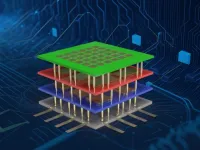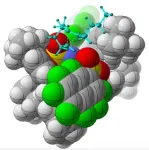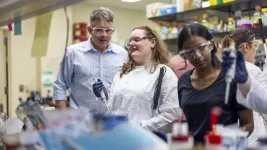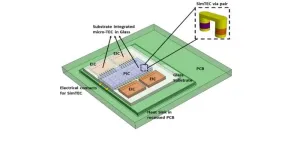(Press-News.org) UNIVERSITY PARK, Pa. — Moore's Law, a fundamental scaling principle for electronic devices, forecasts that the number of transistors on a chip will double every two years, ensuring more computing power — but a limit exists.
Today's most advanced chips house nearly 50 billion transistors within a space no larger than your thumbnail. The task of cramming even more transistors into that confined area has become more and more difficult, according to Penn State researchers.
In a study published today (Jan. 10) in the journal Nature, Saptarshi Das, an associate professor of engineering science and mechanics and co-corresponding author of the study, and his team suggest a remedy: seamlessly implementing 3D integration with 2D materials.
In the semiconductor world, 3D integration means vertically stacking multiple layers of semiconductor devices. This approach not only facilitates the packing of more silicon-based transistors onto a computer chip, commonly referred to as “More Moore,” but also permits the use of transistors made from 2D materials to incorporate diverse functionalities within various layers of the stack, a concept known as “More than Moore.”
With the work outlined in the study, Saptarshi and the team demonstrate feasible paths beyond scaling current tech to achieve both More Moore and More than Moore through monolithic 3D integration. Monolithic 3D integration is a fabrication process wherein researchers directly make the devices on the one below, as compared to the traditional process of stacking independently fabricated layers.
“Monolithic 3D integration offers the highest density of vertical connections as it does not rely on bonding of two pre-patterned chips — which would require microbumps where two chips are bonded together — so you have more space to make connections,” said Najam Sakib, graduate research assistant in engineering science and mechanics and co-author of the study.
Monolithic 3D integration faces significant challenges, though, according to Darsith Jayachandran, graduate research assistant in engineering science and mechanics and co-corresponding author of the study, since conventional silicon components would melt under the processing temperatures.
“One challenge is the process temperature ceiling of 450 degrees Celsius (C) for back-end integration for silicon-based chips — our monolithic 3D integration approach drops that temperate significantly to less than 200 C,” Jayachandran said, explaining that the process temperature ceiling is the maximum temperature allowed before damaging the prefabricated structures. “Incompatible process temperature budgets make monolithic 3D integration challenging with silicon chips, but 2D materials can withstand temperatures needed for the process.”
The researchers used existing techniques for their approach, but they are the first to successfully achieve monolithic 3D integration at this scale using 2D transistors made with 2D semiconductors called transition metal dichalcogenides.
The ability to vertically stack the devices in 3D integration also enabled more energy-efficient computing because it solved a surprising problem for such tiny things as transistors on a computer chip: distance.
"By stacking devices vertically on top of each other, you're decreasing the distance between devices, and therefore, you're decreasing the lag and also the power consumption,” said Rahul Pendurthi, graduate research assistant in engineering science and mechanics and co-corresponding author of the study.
By decreasing the distance between devices, the researchers achieved “More Moore.” By incorporating transistors made with 2D materials, the researchers met the “More than Moore” criterion as well. The 2D materials are known for their unique electronic and optical properties, including sensitivity to light, which makes these materials ideal as sensors. This is useful, the researchers said, as the number of connected devices and edge devices — things like smartphones or wireless home weather stations that gather data on the ‘edge’ of a network — continue to increase.
"’More Than Moore’ refers to a concept in the tech world where we are not just making computer chips smaller and faster, but also with more functionalities,” said Muhtasim Ul Karim Sadaf, graduate research assistant in engineering science and mechanics and co-author of the study. “It is about adding new and useful features to our electronic devices, like better sensors, improved battery management or other special functions, to make our gadgets smarter and more versatile.”
Using 2D devices for 3D integration has several other advantages, the researchers said. One is superior carrier mobility, which refers to how an electrical charge is carried in semiconductor materials. Another is being ultra-thin, enabling the researchers to fit more transistors on each tier of the 3D integration and enable more computing power.
While most academic research involves small-scale prototypes, this study demonstrated 3D integration at a massive scale, characterizing tens of thousands of devices. According to Das, this achievement bridges the gap between academia and industry and could lead to future partnerships where industry leverages Penn State’s 2D materials expertise and facilities. The advance in scaling was enabled by the availability of high-quality, wafer-scale transition metal dichalcogenides developed by researchers at Penn State's Two-Dimensional Crystal Consortium (2DCC-MIP), a U.S. National Science Foundation (NSF) Materials Innovation Platform and national user facility.
"This breakthrough demonstrates yet again the essential role of materials research as the foundation of the semiconductor industry and U.S. competitiveness," said Charles Ying, program director for NSF's Materials Innovation Platforms. "Years of effort by Penn State's Two-Dimensional Crystal Consortium to improve the quality and size of 2D materials have made it possible to achieve 3D integration of semiconductors at a size that can be transformative for electronics."
According to Das, this technological advancement is only the first step.
"Our ability to demonstrate, at wafer scale, a huge number of devices shows that we have been able to translate this research to a scale which can be appreciated by the semiconductor industry,” Das said. “We have put 30,000 transistors in each tier, which may be a record number. This puts Penn State in a very unique position to lead some of the work and partner with the U.S. semiconductor industry in advancing this research.”
Along with Das, Jayachandran, Pendurthi, Sadaf and Sakib, other authors include Andrew Pannone, doctoral student in engineering science and mechanics; Chen Chen, assistant research professor in 2DCC-MIP; Ying Han, postdoctoral researcher in mechanical engineering; Nicholas Trainor, doctoral student in materials science and engineering; Shalini Kumari, postdoctoral scholar; Thomas McKnight, doctoral student in materials science and engineering; Joan Redwing, director of the 2DCC-MIP and distinguished professor of materials science and engineering and of electrical engineering; and Yang Yang, assistant professor of engineering science and mechanics.
The U.S. National Science Foundation and Army Research Office supported this research.
END
Integrating dimensions to get more out of Moore’s Law and advance electronics
2024-01-10
ELSE PRESS RELEASES FROM THIS DATE:
Need for speed: How hummingbirds switch mental gears in flight
2024-01-10
Hummingbirds use two distinct sensory strategies to control their flight, depending on whether they’re hovering or in forward motion, according to new research by University of British Columbia (UBC) zoologists.
“When in forward fight, hummingbirds rely on what we call an ‘internal forward model’—almost an ingrained, intuitive autopilot—to gauge speed,” says Dr. Vikram B. Baliga, lead author of a new study on hummingbird locomotion published in Proceedings of the Royal Society B. ...
Wristband monitors provide detailed account of air pollution exposure
2024-01-10
Environmental epidemiologists at Columbia University Mailman School of Public Health, in collaboration with an interdisciplinary team of researchers at Oregon State University, Pacific Northwest National Labs, and Mt. Sinai School of Medicine, report on the findings of a new study of air pollution exposures collected using personal wristband monitors worn by pregnant individuals in New York City matched with data from a questionnaire. Factors predictive of exposures to air pollution include income, time spent outdoors, maternal age, country of birth, transportation type, and season.
The researchers examined an unprecedented number ...
Scaling up urban agriculture: Research team outlines roadmap
2024-01-10
URBANA, Ill. — Urban agriculture has the potential to decentralize food supplies, provide environmental benefits like wildlife habitat, and mitigate environmental footprints, but researchers have identified knowledge gaps regarding both the benefits and risks of urban agriculture and the social processes of growing more food in urban areas.
In a new paper published in Nature Food, an interdisciplinary group of experts, including a researcher from the University of Illinois Urbana-Champaign, survey ...
Black people face strokes at higher rates, younger ages than white people
2024-01-10
EMBARGOED FOR RELEASE UNTIL 4 P.M. ET, WEDNESDAY, JANUARY 10, 2024
MINNEAPOLIS – Black people consistently had a higher rate of stroke than white people over a recent 22-year period, according to a study published in the January 10, 2024, online issue of Neurology®, the medical journal of the American Academy of Neurology. The study also found that the average age of Black people experiencing stroke was nearly 10 years younger than that of white people, another inequity that grew over time.
“We found that the rate of stroke is decreasing over time in both Black and white people—a very encouraging trend for U.S. prevention efforts,” said study ...
ASBMB announces 2024 class of fellows
2024-01-10
The American Society for Biochemistry and Molecular Biology today announced its 2024 class of fellows. The honorific program recognizes scientists who have made outstanding contributions to the field through their research, teaching, mentoring or other forms of service.
Edward Eisenstein, an associate professor of bioengineering at the University of Maryland and ASBMB Membership Committee chair, and Judith Bond, an adjunct professor of biochemistry and biophysics at the University of North Carolina at Chapel Hill and ...
Researchers step closer to mimicking nature’s mastery of chemistry
2024-01-10
In nature, organic molecules are either left- or right-handed, but synthesizing molecules with a specific “handedness” in a lab is hard to do. Make a drug or enzyme with the wrong “handedness,” and it just won’t work. Now chemists at the University of California, Davis, are getting closer to mimicking nature’s chemical efficiency through computational modeling and physical experimentation.
In a study appearing Jan. 10 in Nature, Professor Dean Tantillo, graduate students William DeSnoo and Croix Laconsay, and colleagues at the Max Planck ...
Dark web fentanyl-selling operations have grown rapidly, offer steep discounts
2024-01-10
Overdose deaths in North America have skyrocketed, primarily because of the spread of illegally manufactured fentanyl. In a new study, researchers analyzed an early and prominent fentanyl-selling operation on the dark web. The organization sustained a significant growth rate, which allowed it to offer consumers steep discounts. In light of these findings, the authors conclude that it might be challenging to constrain supply by shuttering individual organizations since remaining organizations could grow rapidly to fill unmet demand.
The study was conducted by researchers at Carnegie ...
Can drinking alkaline water help prevent kidney stones? Not likely, study finds
2024-01-10
Waltham — January 10, 2024 — Bottled water marketed as "alkaline water" is unlikely to be an effective alternative for prevention of recurrent urinary stones, reports a study in the January issue of The Journal of Urology®, an Official Journal of the American Urological Association (AUA). The journal is published in the Lippincott portfolio by Wolters Kluwer.
"While alkaline water products have a higher pH than regular water, they have a negligible alkali content – ...
Tactile lithophane development makes hard scientific data available to students with blindness
2024-01-10
WACO, Texas (Jan. 10, 2024) – A first-of-its-kind tactile learning device developed by Baylor University chemistry professors to make science accessible to students with blindness or low vision (BLV) has opened the possibility of the transfer of any scientific data or images for sighted students into functional, thorough formats for students with blindness. The study was published today in the journal Science Advances.
The latest research from Bryan F. Shaw, Ph.D., professor of chemistry and biochemistry at Baylor, focused on the development of a codex using lithophane – an ancient art form – to convert images from scientific textbooks into tactile ...
Glass packaging with a mix of thermoelectric in the vias
2024-01-10
Photonics offers various advantages, including enablement of high-speed and low-loss communication by leveraging light properties in optical data communication, biomedical applications, automotive technology, and artificial intelligence domains. These advantages are realized through complex photonic circuits, comprising diverse photonic elements that are integrated on a photonic chip. Electronic chips are then added to supplement the photonic chips for certain functions, such as light source operation, modulation, and amplification. The close integration of electronic and photonic chips on a substrate is a critical aspect of photonic packaging.
Photonic packaging plays a vital role in ...







